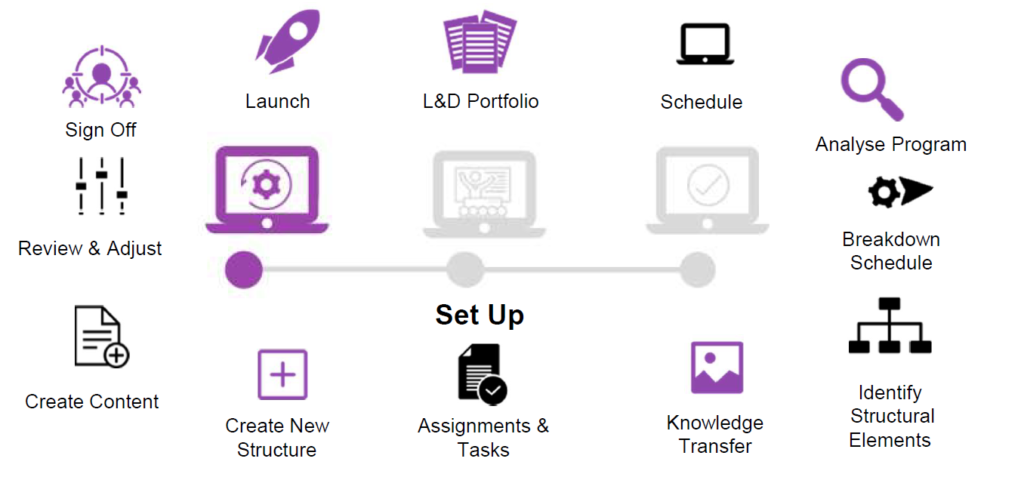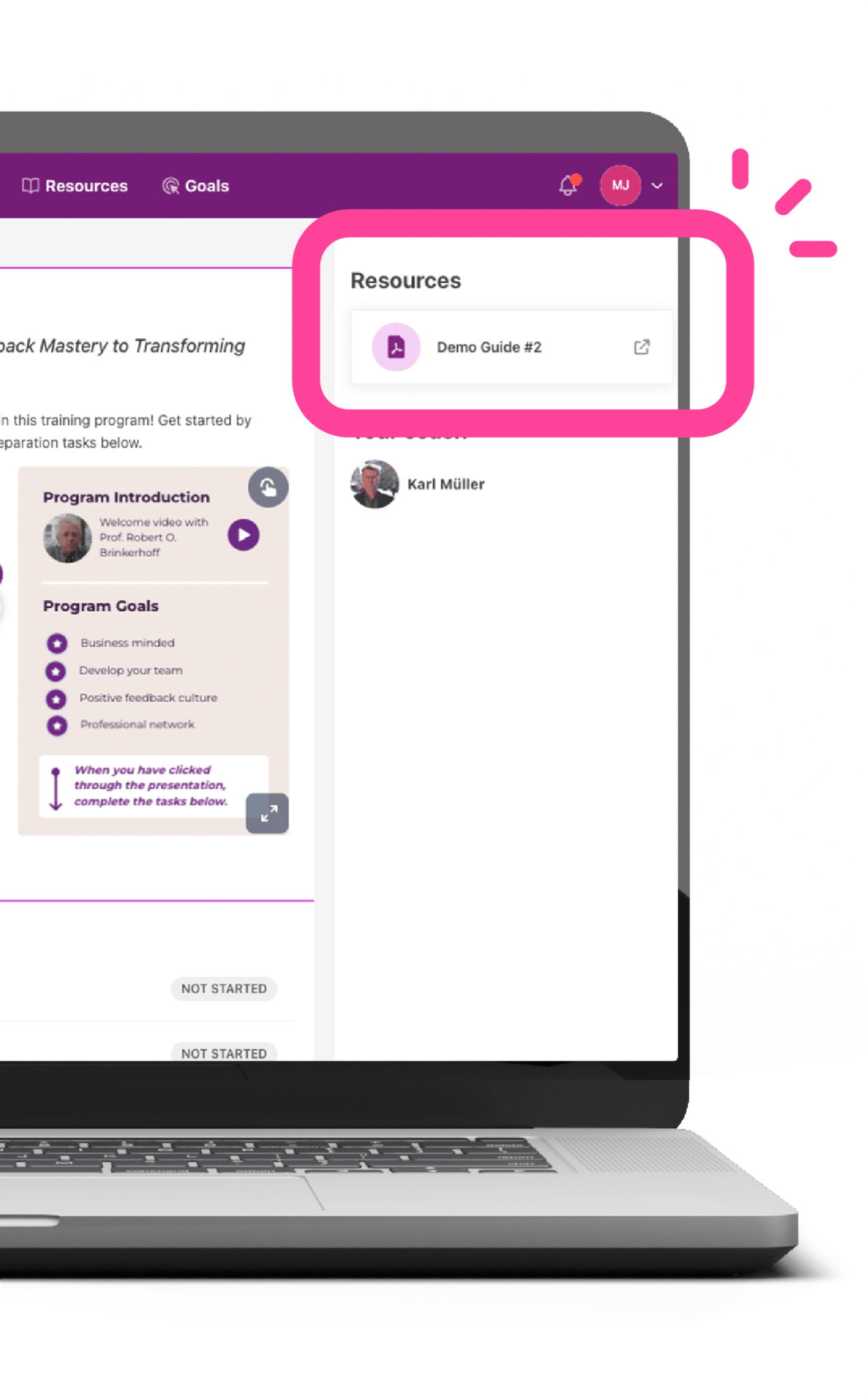Vi har under åren sett en hel del förändringar kring organisationer som alltmer integrerar en mer blandad strategi när det kommer till deras L&D initiativ. Det här har accelererat de senaste månaderna på grund av behovet att ha virtuella leveranser som standard. Det verkar vara två läger när det kommer till vad som ska hända härnäst. Kommer vi att återgå till ett mer traditionellt tillvägagångssätt med kursledare, face-to-face-program och klassrumsledd utbildning eller kommer det finnas ett behov att tillämpa ett mer blandat tillvägagångssätt där vi integrerar digital support och virtuell leverans som standard. Vi tror på det senare, mest för att vi kan uppnå bättre effekt och resultat med den här metoden, inte enbart som en reaktion av pandemin.
Vad är ett Learning & Development ekosystem?
Det är inte helt utan utmaning att skapa ett effektivt Learning & Development ekosystem och det krävs några hörnstenar för att göra det på ett framgångsrikt och hållbart sätt. För oss är ett Learning & Development ekosystem när människor, teknologi, innehåll, kultur och strategi arbetar i harmoni för att producera L&D initiativ som påverkar organisationen. Utmaningen som kan uppstå är när organisationen kanske redan har en del av hörnstenarna, men inte alla. Utan alla delar kan de dock inte uppnå ett effektivt system som producerar det önskade resultatet.
Grunderna är fyrfaldigt:
- Ha en blandad utbildningsmetod i ditt mindset, det möjliggör design och uppbyggnaden av effektiva utbildningsprogram.
- Ha en effektiv digital plattform, för att stödja lärresan över tid och samtidigt med ett fokus på att deltagarna tillämpar de nya kunskaperna.
- Använda ett virtuellt verktyg integrerat med rätt klassrumsfunktion för att skapa engagemanget hos deltagarna.
- Möjligheten att skapa och tillämpa meningsfullt digitalt innehåll.
Att ha en blandad utbildningsmetod i sitt mindset
Att förändra sitt mindset är kanske den största utmaningen av alla och det har en direkt påverkan på de andra tre hörnstenarna i vårt ekosystem. Utbildning har varit så dominerat av den klassrumsledda metoden att bara föreslå en förflyttning till digital utbildning kan få starkt mothugg. Kanske till och med i den starkaste formen från kursledarna själva, som har byggt upp kunskapen och egenskaperna att leverera i det fysiska klassrummet. En blandad utbildning skulle inte bara kräva ett ändrat mindset utan även andra egenskaper. Mindre tid kommer att spenderas på att vara stjärnan på scenen, istället kommer det handla om att direkt guida deltagarna mot tillämpning och assistera dem i det.
Det kan också vara en del mothugg inom organisationen, precis som att kursledarna är vana vid att leverera i klassrummet, är deltagarna vana vid att hämta kunskapen därifrån. Att ändra tillvägagångssätt kan verka riskabelt, det finns också en oro för hur det här påverkar deltagarna med den principiella frågan ”hur länge kommer de vara borta från arbetet?”.
Det tar tid för en ny, blandad strategi att nå fram genom sin väg ut i organisationen. Vi har erfarenhet av att prova att skapa en ”big bang” effekt där vi försökt lansera en idé snabbt. För det mesta har det varit minst framgångsrikt. Det vi istället ser som en framgångsrik process är att ta det gradvis, steg för steg. Då ett program introduceras lite i taget och att framgångsfaktorerna från det sprider sig genom organisationen. Att bistå med support i hur ett program skapas och faciliteras i den digitala plattformen, hur man faciliterar i ett virtuellt klassrum, och hur man skapar en kärna av människor som kan applicera ett mindset med den blandade utbildningsstrategin hjälper också. Det här har skapat mer framgång även när det gäller att få med sig både kursledare och deltagare och vad vi faktiskt kan åstadkomma genom att verkligen använda fördelarna med de digitala verktygen. Dock är en hörnsten att skapa support till dem, någon som kan ”felsöka”, guida och vara där som stöd när saker inte riktigt går som planerat.
Digitala stödplattformar
En digital plattform har tidigare kanske setts som en ”nice-to-have”. Ett komplement till ett existerande LMS som kan stötta strukturen och interaktionen av ett program och samtidigt som det på ett effektivt sätt levererar förberedande uppgifter och support efter själva kurstillfället. Däremot har det blivit allt tydligare att om vi verkligen vill skapa en högre deltagarinteraktion, mellan deltagarna själva, mellan cheferna och med kursledarna kan inte LMS leverera exakt det som behövs. Dessutom om vi vill, med kvalitativt underlag, kunna påvisa att kunskapen faktiskt tillämpas i rätt situationer, behöver vi mer än att testa deltagarnas nivåer av kunskap – fokuset behöver ligga på vad de faktiskt gör. En digital plattform kan stödja med detta och det är mer av ett krav, ett ”must have”.
En nackdel med digitala plattformar är att de ofta representerar en extra kostnad till en existerande investering som gjorts på ett LMS. Men, om vi kan basera vad vi kan öka i tillämpning genom att använda den typen av plattform, återstår frågan vad är kostnaden att ha ett LMS som inte riktigt levererar vad vi behöver, speciellt i en allt mer digital utbildningsmiljö istället. Det betyder att vi behöver två system, en till den administrativa sidan och en som levererar utbildningsprogrammet om vi är, genom vår strategi, i stånd till att förflytta oss framåt.
Virtuella klassrum
Användningen av digitala mötesverktyg har skjutit i höjden över det senaste månaderna som en nödvändighet för att kunna arbeta på distans. Många inom L&D har infört de digitala verktygen för att leverera virtuella program. Även om det används har det primärt varit som en transport från det fysiska klassrummet till den digitala miljön. Det var en rimlig tillämpning när det verkade som att de fysiska mötena endast skulle påverkas kortsiktigt. De här verktygen är ett sätt för oss att kommunicera med våra deltagare virtuellt men det har ett pris. Alltför ofta har jag bevittnat en grupp av deltagare som är helt slut efter en dag av virtuell utbildning – även kursledaren – när de har en dag eller flera dagar kvar av utbildningen. Framöver behöver vi anpassa tillämpningen av vårt virtuella klassrum, ha fler men kortare sessioner, medan vi använder varierande funktioner för att stötta engagemanget. Plötsligt har utbudet av de befintliga verktygen som stödjer detta minskat drastiskt.
Det finns alternativ som kan replikera mer av interaktionen som finns i klassrummet. Även om det också finns en inlärningskurva i användandet och faciliteringen av dessa. För att verkligen lyckas har vi varit tvungna att visa vägen för organisationen i hur verktygen används och hur de ska faciliteras för att lyckas.
Digitalt innehåll
Med tillämpningen av de digitala metoderna finns det plötsligt ett behov för digitalt innehåll som kan användas i utbildningsprogrammen. Material som var designat för klassrummet passar nödvändigt vis inte in och det har även funnits en stor tillit till kursledaren som levererar teori och metoderna som vi vill föra över till deltagarna. Om vi vill börja leverera det här digitalt behöver vi integrera videoklipp och annat digitalt material.
För att gå ett steg längre, om vi verkligen vill tillhandahålla utbildningsprogram som levererar effekt, behöver vi fokusera på den högt skattade face-to-face-tiden på tillämpning istället för på inlärning, då behöver vi leverera teorin i förhand. Videoklipp kan tillhandahålla detta men då behöver vi skapa materialet. Ett alternativ kan vara att gå till en av de många videobibliotek som finns och köpa materialet, även om det kanske inte är i linje med ditt specifika budskap. Dessutom är videomaterialet tillsammans med andra utgifter ofta kopplade till återkommande kostnader.
Skapa videomaterial är ett område som företagens erfarenhet och förmåga att själva göra skiljer sig åt. Vissa har erbjudit digitalt material sedan en tid tillbaka medan många andra fortfarande inte ens har börjat.
Möjligheten att köpa den kunskapen som behövs kan bli kostsamt och behöver inte nödvändigtvis lösa problemet med förmågan att leverera ”on screen”. Processen behöver varken vara komplicerad eller kostsam, men det krävs noggrann planering och förståelse för nivån av professionalism som är förväntad från deltagarna.
Tillämpningen av den blandade strategin som integrerar inte bara de digitala verktygen men även det flexibla mindset har sakta ökat bland kursledarna. För att skapa ett effektivt L&D ekosystem krävs en förändring och med förändring kommer utmaningarna. Utmaningarna är inte oöverkomliga men kräver tid, hårt arbete, kunskap och en investering för en framgångsrik lansering. Belöningen för genomförandet är tydliga: Vi kan erbjuda möjlighet att skala upp, reducerade kostnader, ökad effekt och L&D utbildningsprogram som i längre utsträckning möter organisationens krav.
Vill du veta mer? Titta på vårt tidigare webbinar!
Här kan du titta på vårt webbinar med Alex Brittain-Catlin och Mark Gussetti: “Creating a Sustainable L&D Ecosystem“.


